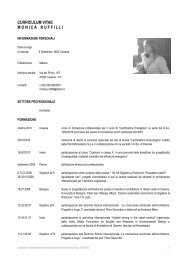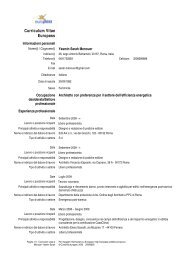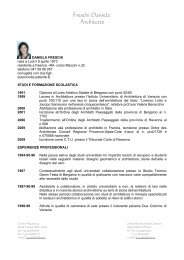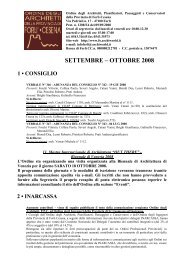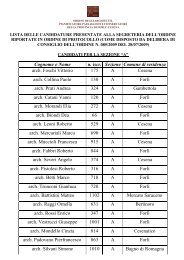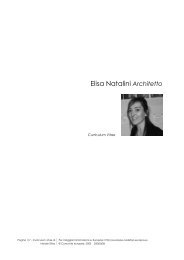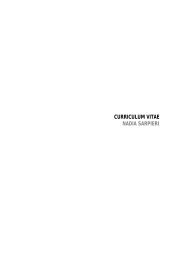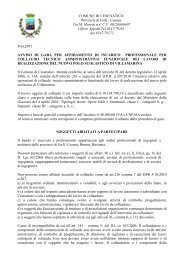CHIARA TASSINARI Portfolio 2010
CHIARA TASSINARI Portfolio 2010
CHIARA TASSINARI Portfolio 2010
You also want an ePaper? Increase the reach of your titles
YUMPU automatically turns print PDFs into web optimized ePapers that Google loves.
A new concept of town should be conceived on<br />
the basis of a model linking the development of<br />
the town to the enhancement of its surrounding<br />
landscape value, both by valorising the existing<br />
vegetation and by paying more attention to the<br />
exploitation of the environmental resources.<br />
The urban sustainability is based on the ability<br />
to regenerate non-regenerating natural<br />
resources (air and water), to limit the intensive<br />
exploitation of land, and to ensure<br />
theenvironmental compatibility of infrastructures<br />
and mobility.<br />
The boundary – a privileged area in terms of<br />
landscape – should result from the intersection<br />
of different interventions, not always related to<br />
the building activity (i.e. roads, squares, parks,<br />
etc.), and the rural organisation of the territory.<br />
Hence, these areas may be designed as a<br />
whole with the “central” ones, avoiding the<br />
current distinction between the centre and the<br />
outer city. The borders of the town will also<br />
become qualitatively significant.<br />
Extending the concept of multicentricity from the<br />
borders to the centre, it is possible to establish<br />
the total territorial surface of the town as well as<br />
its shape, defined by a network of roads,<br />
squares and blocks. This system is very simple<br />
and allows to create - even in different steps -<br />
districts and parts of the town, which are at the<br />
same time different and similar because of the<br />
same scheme.<br />
The new structure proposed for Sukari, with its<br />
multifunctional network of town-districts,<br />
integrates the centre and the outer city instead<br />
of privileging one over the other.<br />
The services should be organised according to<br />
the three territorial levels that compose and<br />
identify the town: blocks (about 3-5,000<br />
inhabitants), districts (about 15,000 inhabitants),<br />
and urban areas (about 45,000 inhabitants).<br />
From a functional point of view, any activity<br />
aimed at meeting a common social need has<br />
been considered as a service.<br />
The types of services identified are the<br />
following: education, health and social care,<br />
culture and entertainment, trade, green<br />
recreation spaces, sport, religion, safety,<br />
transport, waste collection, local administration.<br />
Each identified territorial level should be<br />
assigned specific service structures,<br />
proportional<br />
to the number of users. For example, in the field<br />
of education, the block should be assigned an<br />
early childhood centre and a nursery school,<br />
while the district and the urban area should be<br />
assigned a primary and secondary school and a<br />
high school, respectively.<br />
This system should be extended to all the<br />
services, in order to ensure each part of the<br />
town a different accessibility level: on foot<br />
(blocks), by bike or the public transport system<br />
(district) and by private vehicles (urban areas).<br />
The general urban quality of the town of Sukari<br />
as well as the scope of each residential and<br />
productive intervention should be identified by<br />
the services network, on the basis of a<br />
progressive development of the settlement that<br />
should be completed within approximately 20-<br />
30 years.



